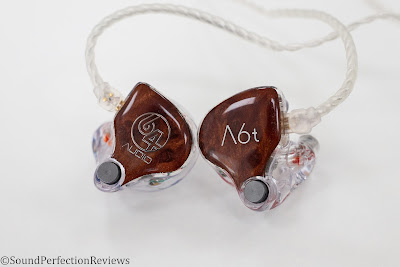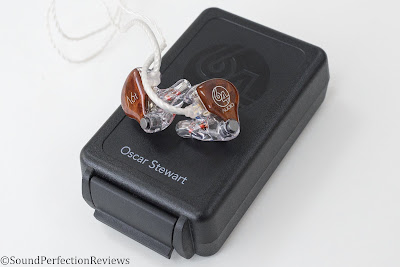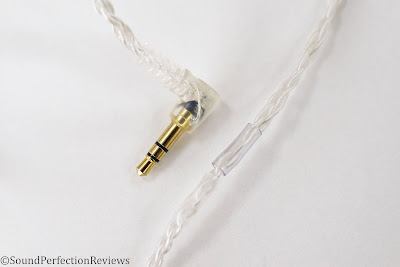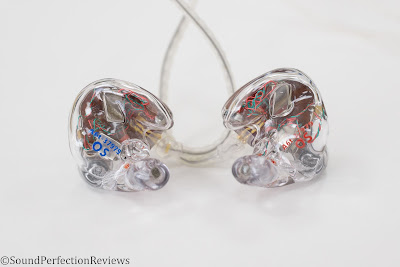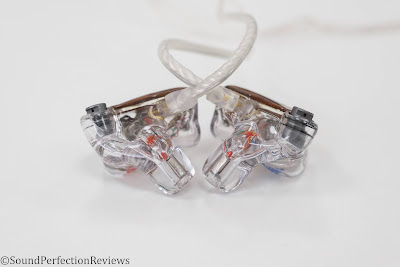DISCLAIMER: Music Sanctuary (64 Audio’s Singaporean distributor) provided me with a discounted price on the A6t in return for my honest opinion. I am not personally affiliated with the companies in any way, nor do I receive any monetary rewards for a positive evaluation. I’d like to thank them and 64 Audio for their kindness and support. The review is as follows.
64 Audio is one of the most well-renowned custom in-ear brands in the world today. Founded in 2010 as 1964Ears, the American enterprise have gone on to become a first-choice for audiophiles
and professional musicians – endorsing the likes of Nathan East, Beyoncé, and Kanye West. In addition, they’ve pioneered a staggering number of new technologies. Their
apex modules relieve pressure for extended listening comfort and safety, their 3D-Fit process ensures the speed, precision and reliability of 3D-printing, and their open
tia drivers deliver crisp, airy and extended highs to every model. Today, we’ll be looking at their new mid-tier reference – the A6t – to see what it brings to audiophiles and engineers alike.
64 Audio A6t
- Driver count: Six balanced-armature drivers
- Impedance: 10Ω @ 1kHz
- Sensitivity: 108dB @ 1mW
- Key features (if any): apex, LID technology, 3D-Fit, tia high driver
- Available form factor(s): Custom acrylic IEM
- Price: $1299
- Website: www.64audio.com
Build and Accessories
The A6t comes in 64 Audio’s standard packaging: A sleeved box adorned with high-res prints and glossy accents on
all sides, indicative of the company’s attention to detail and commercial flair. Removing the sleeve reveals the included carrying case, which can be personalised with the owner’s name, as well as custom graphics at an added cost. The case is clamshell-esque with a secure latch for more extreme use cases. Within are the in-ears themselves – with the stock cable securely wound on a post – along with a shirt clip, a cleaning tool and desiccant. At this price point, audiophiles would probably expect a microfibre cloth and an additional mini case, but 64 Audio at least provides all the essentials.
Despite the impressive finish, I’m a tad concerned with the carrying case. There’s a lightweight, plasticky quality to it that screams neither luxury nor security as readily as the ubiquitous
Pelican cases do. With products at this caliber, I’d expect sturdier, more metallic elements infused within the plastic. That way, both protection
and presentation improve without heavily altering the final MSRP. With that said, the interior of the case was
very cleverly thought-out. Each trinket has its own isolated compartment designed for minimal contact (so, nothing bumps against each other). Additional structures were conceived for cable winding, desiccant and extra
apex modules – all within an
impressively compact form factor.
The in-ears themselves look and feel absolutely remarkable. Despite the 3D-printing process, the shells are impressively clear – more so than most 3D-printed shells I’ve seen – and finish as a whole is great, but not perfect, unfortunately. A couple dull spots, print lines and tiny bubbles prevent a flawless finish. But with that said, lacquer work is great for the most part and these shells are the most robust I’ve experienced yet. They hold a real sense of density and weight that suggests high durability in the long term. The Elmwood Burl inlays react wonderfully to light; highlighting the tiny grains against the surface below. And, the metallic logos are among the cleanest and most sophisticated I’ve seen of its kind.
3D-Fit
64 Audio is one of few who’ve transitioned into a fully-computerised manufacturing process. This means the ear moulds are scanned and edited entirely in software, yielding several advantages. Digitised trimming grants superior control and fidelity than hand-trimming. It also allows the user to undo any potential error; impossible with physical impressions. Rather than the traditional wax-dipping stage, the moulds are smoothened digitally as well, which preserves greater detail. Finally, the finished shape is printed in acrylic with its peripheral structures, i.e. the
apex port and the
tia bore.
Along with advantages throughout production, the 3D-Fit process benefits commercially as well. Digital processing yields faster turnaround times. I received my retail pair within three weeks of placing the order, which is the shortest I’ve had to wait for a custom IEM since my locally-made, similarly-3D-printed Avara Custom AV2. In addition, since my moulds have been stored digitally at 64 Audio HQ, they’ll be able to reuse them for future purchases and guarantee a verbatim fit. This perk
may also be offered by non-3D-printing brands, but the perishable nature of their silicone/crystalloid casts means a facsimile fit cannot be guaranteed. And, you may need to send in new impressions after a couple years’ time.
For its many pros however, 3D-printing does have its share of cons. 64 Audio limits their shell colours to five options, which is
sorely scarce considering most of the competition offer somewhere between 20-40 standard colours. That figure grows even larger when you include custom-mixed colours, glittered dyes and artistic swirls, which – again – 64 Audio aren’t able to replicate with their current techniques. The 3D-printing process also requires a lot more post-processing than hand-poured shells do, lest they look cloudy and unpleasant. Admittedly, 64 Audio’s clear shells here are
fantastic – illustrious and clear. But, it does have dull spots and print lines here and there, so it’s not perfect.
Now, with all this in mind, how do the in-ears fit? Very,
very securely. Relative to my other customs, the A6t are far-and-away the most detailed in shape. Part of this is the fidelity of the 3D-Fit manufacturing process; preserving bends and twists that were smoothened down in previous customs. But, it’s also because 64 Audio’s fitting policies shave
very little off of the original moulds. They preserve the whole concha and maintain as much girth as possible. On the plus side, this results in a secure fit with zero sloshing noises when I flex my ears, chew or talk. On the other hand, they are rather tight to wear. A slight outward pressure exists when they’re in the ear, followed by slight discomfort after a couple hours. But, this is very much adaptable over time. The discomfort ceases to exist after a week or so of daily wear.
apex
apex technology is pitched as a pressure-relief system designed to rid the ear canal of pneumatic pressure. 64 Audio claims this pressure causes ear fatigue at a faster rate, so
apex was developed to grant the user a safer, longer-lasting listening experience.
apex comes in two flavours: M15 and M20. The numbers denote the amount of isolation the two modules provide – M15 being -15dB and M20 being -20dB. A solid module (dubbed
M26) is offered as well for their earplug range, but is not recommended for use with IEMs because it entirely cancels out
apex and dramatically alters sound. Due to the somewhat semi-open nature of this technology as well, 64 Audio promises a wider, more open stage.
In real-life use, the effects of
apex are more palpable when you listen at louder-than-average volumes. Personally, I listen at low-to-average SPLs, so ear fatigue sets in rather slowly for non-
apex in-ears too. What I can say
apex accomplishes is what feels like heightened headroom. For the A6t’s lively signature, the soundscape rarely ever fills overtly saturated or
loud. So, although I can’t say it’s a vastly different experience in terms of ear fatigue, I can say that it serves dividends in
listening fatigue. Where an energetic signature like this would tire me mentally, the A6t does not most of the time.
With that said, the interchangeable modules do offer great customisability. Switching between the M15 and the M20 yields different bass responses. The former presents a more linear low-end in line with the midrange – ideal for vocal-focused genres. Meanwhile, the latter boosts the sub-100Hz region by a touch. This results in a more forwardly-placed, excited bass response and adds richness to instruments as well. But at the end of the day, it’s worth noting that both offer less isolation than the -26dB that typical non-
apex customs offer. If you do prioritise isolation, you may want to either look at other options or invest in a pair of 64 Audio’s EP-C Solid Earplugs which come with the M26 module.
tia
tia stands for
tubeless in-ear audio: 64 Audio’s solution towards achieving a crisp, well-extended and resonance-free treble response. Essentially, it’s a balanced-armature tweeter with the top cap removed. So, instead of firing through a spout and into a tube like traditional armatures, the tweeter radiates freely at the tip of the canal. To prevent debris and ear wax from entering and damaging the open driver, a wax guard is securely placed at the very end of the single bore.
Their sonic benefits will be elaborated upon in the next page, but it should be noted that a vacuum designed for in-ear-monitor use is ideal for such a design. This is because using the included cleaning tool to scrape off earwax may instead cause it to break up and fall through the mesh
or damage the mesh itself. The immensely popular Jodi-Vac Consumer is an adequate solution, but the included needle was designed for traditional 1-2mm bores; rather than the
tia bores. Personally, I’d recommend FIR Audio’s Headphone Vac, which has a larger head specifically designed for these bores.
LID Technology
LID (
Linear
Impedance
Drive) technology is 64 Audio’s solution against frequency response alterations based on output impedance. This is very reminiscent of Custom Art’s FIBAE technology (described
here) which guarantees a consistent signature regardless of source. In practice, LID does most of what the packet says. Between my MacBook Pro and my Sony WM1A for example, tonal balance is relatively similar. However, differences in resolution and imaging still exist. Instruments on the WM1A sound more physical and holographic, due to the player’s superior DAC. Nevertheless, it’s a nifty feature, especially for myself as an engineer, where I’m plugging my in-ears into a variety of consoles and amps.
Presentation
64 Audio’s A6t is a lively, musical and engaging piece. It evokes excitement by virtue of contrast; between its lifted bass and
tia‘s signature crisp, airy and articulate treble. But ultimately, the key to its success lies in the midrange – full-bodied, dense and wonderfully balanced in tone. The A6t sets itself apart by placing a significant emphasis on vocal structure. A balance between transient and harmonic (i.e.
pop and
decay) guarantees the A6t never fatigues in its quest for dynamic range, clarity and musicality. Although it isn’t the smoothest around – as we’ll explore in the
Treble section – there’s a clear sense of maturity in the A6t’s framework; one that favours timbre as it does long-term engagement and pleasure.
That is made all the more crucial when you consider the A6t’s stage. Lacklustre it is
not, but transparency is limited by headroom and stability. There’s sufficient space for the A6t to
work, but not much for it to
breathe. Although they’re never congested by
any stretch of the imagination, instruments tend to fill the stage rather rapidly. Imaging precision isn’t necessarily its forte. At its price, the A6t performs
perfectly adequately – I’d love nothing more than to see it push more boundaries; literally. However, despite its undesirable effects towards technical prowess, its coalesced-ness
does inject a fair bit of musicality into the mix. There’s simply something alluring and
human about watching a band play and hearing all their sounds
blend into each other. It adds to the A6t’s charisma and – to many – shouldn’t be taken away.
Bass
The A6t has a moderately boosted low-end, with an emphasis on the sub- and mid-bass. It droops towards neutral as it approaches the upper-bass and the lower-mids. As a result, the A6t’s low-end is more kinetic and textured than rich and warm. Bass notes are more impact-inclined, so the stage remains clean for the midrange to perform. Secondly, it adds great theatricality to bass drops and riffs. Tracks like Sabrina Claudio’s
Don’t Let Me Down – which start bass-less before kicking into high gear – achieve
great dynamic range. There’s a genuine feeling of satisfaction as the low-end enters the fray. But on the other hand, this response
limits the dynamic range of more melodic bass instruments. Upright basses and tom toms sound plucky (or rather,
skin-y for the latter) – mellow and nonchalant, rather than warm and resonant.
This can certainly be attributed to priority. Sarah McKenzie’s rendition of
That’s It, I Quit! opens with double bass and you wonder,
“Where’s the fullness? The emotion? The radiant, woody warmth?” But, play Gallant’s
Cave Me In with its deep, electronic bass line and go,
“Oh, so that’s where those two woofers have gone.” This is where the A6t’s low-end truly shines – as a guttural, visceral and immensely satisfying rhythmic drive. You can also experience this on the Kanye-West-produced track, Pusha-T’s
If You Know, You Know. Again, the track starts off almost a capella, before the beat announces its presence with – on the A6t – authority, rumble and pleasure to spare. It’s a low-end that aims towards physicality rather than tone, and thus performs better with certain genres than others. Admittedly though, it delivers its fortes with
immense skill, whilst serviceably fulfilling its role as a bridge towards the lower-mids at the same time – thumbs up.
Midrange
To me, the midrange is what anchors the A6t’s presentation. It possesses an alluring mix of density, refinement and clarity that manages to sound neither cloy, nor honky, nor overtly saturated; simply, balanced. A rise between 1-2kHz contributes solidity. Instruments sound physically present as full-bodied images, rather than wispy wraiths. And, lower-pitched elements like the rhythm guitars on Lake Street Dive’s
Baby Don’t Leave Me Alone With My Thoughts project with force too. In addition to the robustness it imparts onto the rest of the cast – including Rachael Price’s swagger-ous lead vocals – the whole ensemble comes alive with a lively punchiness; not to mention the clarity that
tia brings. Then, higher-pitched vocalists like Stanaj and Julia Stone benefit from this as well. It solidifies their harmonics and provides a chesty foundation of sorts, which in turn supports the upper-mids and lower-treble as they belt higher up their ranges.
In turn, the A6t’s upper-mids come across balanced too. While the trend nowadays is to tilt towards 3kHz for vibrancy and presence, the A6t levels it flat for a more solid, concentrated presentation. Again, you won’t get those sweet, soft, wispy vocals that lull you to sleep. Rather, what you’ll hear are hearty, fibrous instruments with force stemming more from the chest than the mouth or nose; less
light and twangy, more
grunt-y. But, there’s certainly enough liveliness here for musicality’s sake as well. Vocalists are at the forefront of the A6t’s
loud and proud presentation – again owing to the physicality of the centre-mids – belting with effort you can genuinely feel. If you you tend to favour signatures where the vocalists are surrounded by miles of space for echoes and reverbs to ring through, effectively whispering the tune all the while, the A6t will not be for you. But, if you favour a mid-focused presentation where you can hear balladeers truly flex their vocal chords (even when they perhaps aren’t doing so in the recording), the A6t’s fibrous midrange truly is a treat.
Treble
Top-end performance has clearly become a hallmark for 64 Audio because of their patent-pending
tia technology. The singular open driver has since trickled down from the critically-acclaimed A18t and Tia Fourté onto their 2018/2019 line-up, including the A6t. Consequently, the six-driver IEM possesses sparkly, clear and crystalline highs that benefit both its musical
and technical performance. Peaks along 7-and-12kHz contribute to the monitor’s sense of rhythm; injecting instruments with crisp, speedy and open transients that complement the rumble of the sub-bass and the density of the midrange. It cuts through all the heft, but without sharpness or haze. The A6t remains consistently composed. Although the
tia driver isn’t necessarily the silkiest or smoothest in the world, it’s at least inoffensive, clear
and refined at all times.
Much of that stems from the restraint 64 Audio was able to show when tuning the A6t’s
tia driver. As we’ve seen with emerging driver technologies – whether it be piezo-electric or electrostatic – there’s a tendency for manufacturers to want to show off their respective characteristics, but to the detriment of the in-ear’s overall balance. Thankfully, the A6t avoids that pitfall for the most part – exhibiting a treble that sits in line with the rest and avoids imparting its own colour into the mix. With that said,
tia does come with its quirks in texture. There’s a certain
tizz to its transients that may put off those looking for a
wholly smooth signature. Again, it’s entirely inoffensive and most-often refined, but it’s no baby’s bottom either. When it comes to spatial performance however,
tia‘s benefits are still undeniable. The open driver brings a sense of openness, air and speed with very minimal brightness; taking top-of-the-line clarity to more attainable terrain.
General Recommendations
The A6t’s energetic-yet-balanced signature makes it suitable for a wide variety of genres. The clarity that the
tia driver brings contributes heavily to this as well. But above all, the following three are traits that the A6t
particularly excels at:
A lively, musical, non-V-shaped sound: The A6t possesses bounds of energy, because of the contrast present between its full-bodied bass and crisp top-end. What sets it apart is the solidity imbued in its midrange. No matter how
loud things get, the lead melody is never lost. So, vocal integrity is never sacrificed in its quest for dynamism – a truly rare trait.
Excellent midrange balance: And, the midrange in and of itself is well-balanced too. It doesn’t overdo liveliness to the point where vocalists are left overtly saturated (read: suffocated), neither does it emphasise harmonics to the point of congestion. Again, it possesses balance, so instruments consistently come across physically-present
and tonally-sound.
A punchy, visceral bass response: One of the A6t’s main draws is the bass it manages to display without intruding on the rest of the ensemble. It does have its share of shortcomings (particularly in terms of timbre). But, if your library mainly consists of pop, hip-hop, EDM and the like, you’ll find
much to love in the A6t’s theatrical, cadence-happy rhythmic drive.
Despite the coherence and balance it manages to consistently maintain, the A6t’s lively, crisp signature may not be for everyone. If the following three traits are what you tend to look for in an in-ear monitor, the A6t may not be for you.
An effortless, nonchalant listen: The A6t is unapologetically impactful through and through. Although that doesn’t translate to fatigue necessarily – and again, it maintains impressive balance regardless – it’s not the type of IEM you sit back and drift away to either. If you prefer a more laid-back, relaxing signature, 64 Audio’s A12t may prove a better fit.
Utmost space and headroom: That liveliness translates to the A6t’s spatial performance as well. Again, it has sufficient space to
work, but barely any to
breathe. Some will enjoy its enthusiasm, while others may tire of it. If you’re looking for higher dynamic range and a more effortless delivery, the higher-end A12t and A18t are more suitable candidates.
A warm, bloomy tone: The A6t’s
tia driver (and lower-mid dip) gives its transients a crisp, definition-focused texture. The upper-bass attenuation also renders the low-end more impactful than emotional; more punchy than resonant. If you’re looking for an IEM with a more natural, organic tone, and a fuller, fatter timbre, 64 Audio’s N8 would probably fit the bill.
Select Comparisons
Empire Ears Phantom ($1799)
The Phantom is Empire Ears’ flagship in the professional space; posited as one of the most natural-sounding, tonally-transparent in-ears on the market today. And truly, that’s what most separates it from the A6t. The Phantom is tuned to be as colourless in tone as possible, allowing the source components and music to dictate its
colour, so to speak. By contrast, the A6t’s crisp, lively signature allows it to possess a clear, articulate and musical profile at all times. Of course, whether either quality is good or bad will depend on the listener; some will prefer adaptability, while others consistency. Many of these discrepancies can be attributed to the treble. The Phantom maintains a linear upper-treble and a lower-treble that peaks around 6kHz. The former gives its transients a softer edge, but the latter makes it prone to brittleness with poorly-produced tracks. Again, the Phantom is less coloured – but also less forgiving – than the generally-lively A6t.
This is because of both in-ears’ lower-mid presentations as well. The A6t presents a more laid-back lower-midrange in an effort to create cleaner transients with greater contrast against the background. Conversely, the Phantom emphasises lower-midrange harmonics. The typical audiophile would call this presentation – in addition to the linear upper-treble –
veiled, but it certainly has its upsides too. Instruments come across richer, fuller and more robust, even though they aren’t necessarily as defined – like a protein drenched in a buttery sauce to help ease it on the palate, so the meat doesn’t come across as fibrous or gristly. Now, that’s not to say the A6t is fibrous or gristly
at all, but lower harmonics are placed further back in its soundscape for a drier presentation. This means the Phantom has the more natural, life-like timbre, but the A6t benefits here in cleanliness and detail. So, it’s certainly preference; moreso than performance.
Alclair Audio Electro ($1499)
Alclair Audio’s Electro is the A6t’s philosophical doppelgänger: A six-driver IEM imbued with innovative technology aimed at professionals
and audiophiles alike. Although they share several similarities, distinct differences exist between them too. The first of which is bass. The Electro possesses a calmer mid-bass, so bass drops and kick drums come through with less thickness and weight relative to the A6t. But, in terms of physical impact, the two are surprisingly similar. This is because of the Electro’s impressive extension, as well as a slight sub-bass lift. So, it punches about as hard as the A6t does with bass-heavy tracks, but without as much fullness. It maintains more headroom that way. However, with less bass-laden tracks, the Electro may lack
oomph to some; too nonchalant. As always, bass comes down to preference.
The Electro also possesses an upper-mid focus, so it comes across more saturated and direct in projection. The mic sounds closer placed toward the vocalist’s mouth, so to speak. But in terms of sheer forwardness, the two aren’t dissimilar because of the A6t’s 1-2kHz hump. Simply, it’s a difference in timbre and structure, rather than level. The key difference in vocal presentation actually lies in the upper-treble. The A6t has a brighter upper-treble, which leads to sharper articulation. The Electro is more laid-back here; opting to sacrifice that last morsel of detail for a more easygoing sound and a longer-lasting listen. Despite this, the Electro goes toe-to-toe with the A6t in imaging and separation. The former’s electrostatic drivers render spatial cues with outstanding finesse. Although the
tia driver performs just as well, there’s an effortlessness with the e-stats that the
tia may lack. But again, it’s a very,
very close race between the two.
Verdict
Amongst the sea of sub-$2000 do-all in-ears in the market today, 64 Audio’s A6t emerges as a true cut above – thriving on youthful zing, tonal finesse and an outstandingly solid midrange. While it boasts a similar liveliness as its peers, a unique physicality accompanies its rhythmic drive. Instruments are not only fun to listen to, but they’re tangible as well. Although it may lack the effortlessness and transparency of 64 Audio’s monstrous flagships, the technology that’s trickled down onto the A6t ensures admirable performance at a fraction of the cost. With 3D-Fit and
apex, you have yourselves one heck of a package. Whether on the go, on stage or behind the desk, the A6t unfailingly delivers punchy, accurate, refined audio. It may not necessarily be 64 Audio’s poster child, but I smell a
clear bestseller for years to come.

